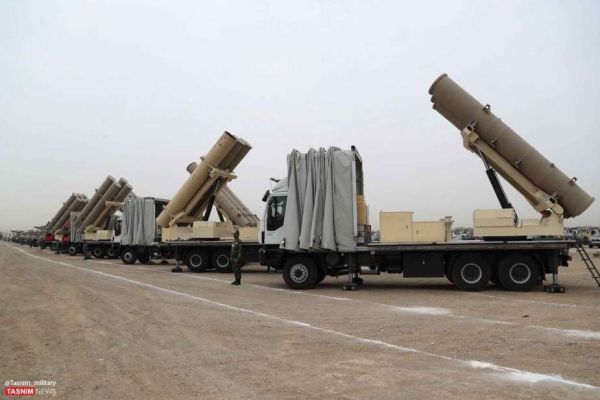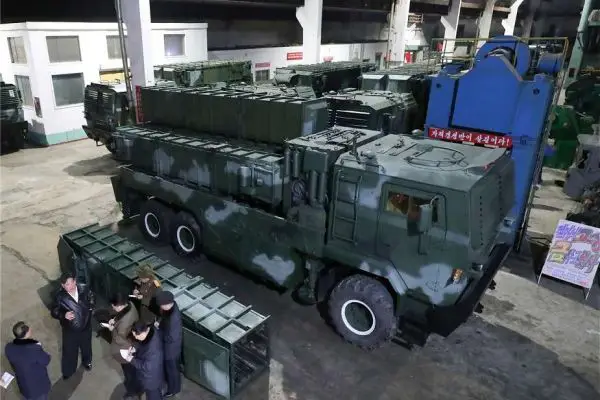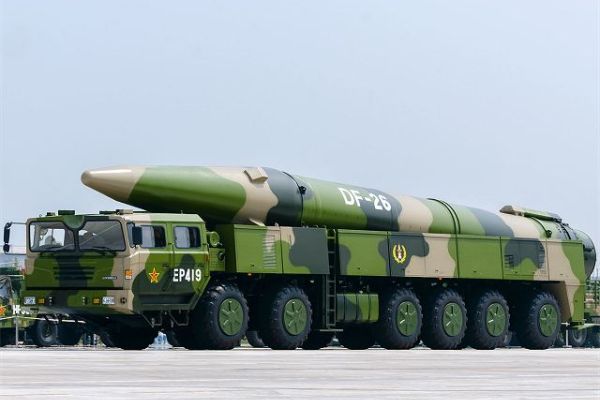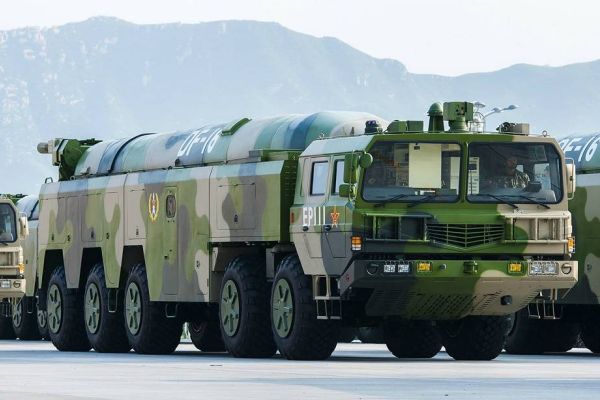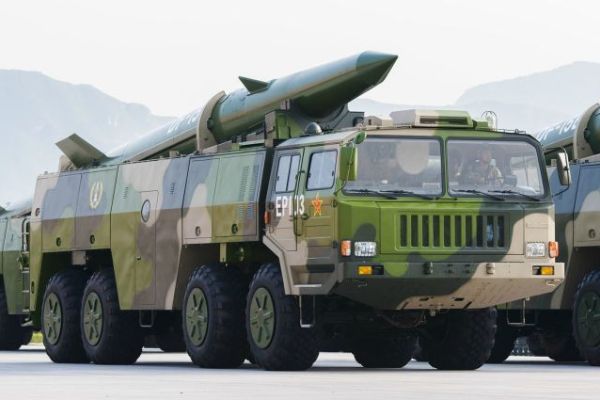Ballistic Missiles.
KN-15 Pukguksong-2.

The KN-15, also known by its official name Pukguksong-2, is a medium-range ballistic missile developed by North Korea. It is part of the Pukguksong (Polaris) family of solid-fueled missiles, which are designed to enhance the country’s strategic deterrence capabilities. The missile is road-mobile and launched from a transporter-erector-launcher (TEL), providing significant flexibility in deployment.
Country users: North Korea, Russia.
Description
The KN-15 Pukguksong-2 is a medium-range ballistic missile (MRBM) that uses a solid-fuel engine. It represents an evolution of North Korea's missile technology, combining features of earlier systems such as the KN-11 submarine-launched ballistic missile (SLBM) and improving upon them with land-based deployment capabilities.
The KN-15 was first publicly tested in February 2017, with its maiden flight occurring on February 12, 2017. The missile is considered a follow-up to the KN-11 (Pukguksong-1), which was primarily a submarine-launched missile. The KN-15 was specifically designed for land-based applications, though its development reflects North Korea's broader goals of creating versatile and survivable nuclear delivery systems. The missile’s solid-fuel design is a significant advancement, as solid-fuel missiles can be prepared for launch more quickly compared to liquid-fuel missiles, improving North Korea's reaction times in a conflict scenario.
The KN-15 entered service with North Korea’s missile forces shortly after its successful tests, likely around 2017 or 2018. It is widely viewed as part of the country's broader strategy to develop a credible deterrent force capable of reaching regional adversaries, such as South Korea and Japan, as well as U.S. military bases in the Pacific region.
The KN-15's primary mission is to provide tactical and strategic deterrence against potential adversaries, particularly the United States, South Korea, and Japan. Its solid-fuel propulsion system and mobile launch platform enable it to be deployed in a mobile, dispersed manner, making it harder to detect and target by enemy reconnaissance or preemptive strikes. It also serves to strengthen North Korea’s nuclear strike capability, providing an option for nuclear payload delivery to a range of regional targets.
KN-15 Pukguksong-2 variants:
No variants at this time
Technical Data
-
Launcher Vehicle
The KN-15 Pukguksong-2 is mounted on a tracked transporter-erector-launcher (TEL) based on a tracked tank chassis. This tracked vehicle offers significant off-road mobility, enhancing the missile's survivability in diverse terrain. The chassis is designed with a crew compartment at the front, where two crew members are located, with two large windows providing visibility for operation. Additionally, other crew positions are on each side at the top roof front of the hull, each equipped with a single door located on the side for access.
When not in use, the missile is carried on the middle of the roof of the vehicle’s hull. During launch preparations, the missile is raised vertically at the rear of the chassis, where it is ready for firing. Two hydraulic jacks are deployed to lower the vehicle onto the ground to ensure stability during launch, providing a secure platform for the missile’s ignition.
The vehicle's suspension system features eight road wheels on each side, with the drive sprocket at the rear and the idler wheel at the front. The suspension system is designed to provide stability and durability over rough terrain. The upper part of the suspension is protected by rubber plates, which shield the components from damage and debris while ensuring smooth movement across various surfaces. This tracked TEL design enables the KN-15 to be launched from concealed and rugged positions, greatly enhancing its mobility and survivability.
-
Missile
The KN-15 is a solid-fueled medium-range ballistic missile that stands approximately 12 m (39 feet) tall with a diameter of around 1 m (3.3 feet). The missile is powered by a solid-propellant engine, which enables it to be stored for extended periods and launched with short preparation times compared to liquid-fueled systems.
The missile carries a single warhead with an estimated range of approximately 1,200 to 2,500 km (750 to 1,550 miles). This range is sufficient to target key regional cities and military installations in South Korea, Japan, and U.S. bases in Guam and Okinawa.
The warhead on the KN-15 is most likely a nuclear payload, though conventional high-explosive warheads could also be used depending on the specific mission. North Korea's advancement in nuclear warhead miniaturization allows for a potent strike capability, even with smaller missile systems.
The aerodynamics of the missile include a conical nose and strap-on boosters, which are typical of solid-fuel ballistic missiles. These features allow the KN-15 to achieve greater speed and altitude during its boost phase, giving it the ability to evade certain missile defense systems.
-
Guidance Systems
The KN-15 missile is equipped with an inertial guidance system (INS), which provides mid-course guidance and allows the missile to follow a pre-programmed trajectory toward its target. It is believed that the missile also incorporates terminal guidance capabilities, potentially including radar or infrared seekers to improve accuracy during re-entry and terminal flight phases.
However, as with many missile systems of North Korea's design, the precise level of sophistication and the degree of accuracy achieved in actual combat scenarios remains somewhat uncertain. The KN-15’s guidance system is likely designed to achieve a reasonable Circular Error Probable (CEP), allowing it to strike a target with a degree of precision sufficient for both conventional and nuclear payloads.
-
Mobility
The KN-15 Pukguksong-2 is based on a tracked transporter-erector-launcher (TEL), which marks a significant departure from North Korea’s earlier mobile missile systems that utilized wheeled TELs. While wheeled TELs are limited to relatively smooth roads and prepared positions, the tracked TEL offers superior off-road mobility, which is crucial for enhancing the system's survivability. This capability allows the missile to be launched from a wider variety of locations, including rugged and remote areas, making it more difficult for adversaries to track and target the system.
The tracked TEL is particularly well-suited for North Korea’s challenging terrain, as the country has only around 700 km of paved road, with much of the infrastructure consisting of narrow, unpaved roads or rough landscapes. The use of a tracked vehicle provides the missile with greater flexibility and the ability to launch from hidden or dispersed positions, minimizing the risks associated with being detected or neutralized during preparations.
-
Combat Use
The KN-15 ballistic missile serves a primarily strategic deterrent role for North Korea. It is designed to deliver nuclear or conventional payloads to regional targets, making it a key asset in North Korea's missile forces. The missile is likely part of a broader strategy to ensure that the country can strike at key adversaries in the event of a conflict, even in the face of preemptive strikes or conventional warfare.
The ability to launch from mobile platforms gives the KN-15 survivability in a potential conflict scenario. In the event of an escalation, the missile can be launched from concealed positions, significantly increasing the difficulty for adversaries to disable or destroy the system before it launches.
As North Korea continues to refine its missile capabilities, it is expected that the KN-15 will continue to evolve as a key element of the nation’s missile and nuclear deterrence posture, likely being integrated into broader offensive strike capabilities targeting not just regional foes but also U.S. and allied forces stationed in the Pacific.
Specifications
-
Type
Medium-range ballistic missile (MRBM)
-
Country users
North Korea, Russia
-
Designer Country
North Korea
-
Guidance System
Inertial Guidance System (INS), possibly with terminal phase guidance (radar or infrared).
-
Warheads Missile
Likely a nuclear warhead (though conventional high-explosive payloads are possible), designed to be sufficiently compact for the missile’s payload bay.
-
Range Missile
Approximately 1,200 to 2,500 km (750 to 1,550 miles), depending on payload and trajectory.
-
Weight Missile
Estimated at around 1,500 to 2,000 kg (3,300 to 4,400 lbs), based on the design of similar missiles.
-
Speed Missile
Estimated Mach 6 to Mach 8 during re-entry phase, with a ballistic trajectory reaching altitudes of up to 500-600 km.
-
Dimensions Missile
Length: Approximately 12 m (39 feet); Diameter: Around 1 m (3.3 feet).
Dimensions (Vehicle): -
Dimensions Vehicle
Length: 16.0 m; Width: 3.0 m; Height: 4.5 m









































